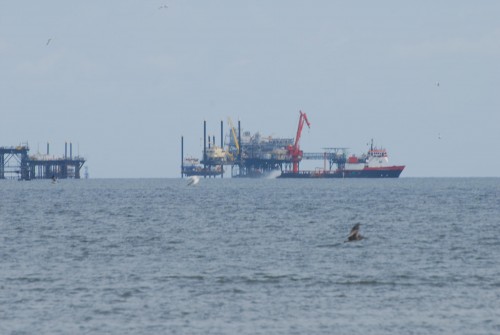
Laf. detention center could be refurbished
August 9, 2011New Orleans Museum of Art (New Orleans)
August 15, 2011An independent study on the oil and gas industry released last month that speaks to the wide-reaching economic impact of the Gulf of Mexico drilling industry made the rounds in Congress and helped provoke additional funding for federal oversight of the oil and gas industry.
Based on analysis by IHS Global Insight and IHS CERA, who specialize in providing business data, the study attempts to quantify the loss of oil production, jobs and tax revenue if the Bureau of Ocean Energy Management, Regulation and Enforcement does not issue permits at a historical pace.
It begins by detailing the backlog of plans pending approval and the decline in permit and plan approvals. The data was pulled from April 10, 2011, and compared to historical averages beginning in Jan. 1, 2005, according to the report.
IHS reports pending deep-water exploration and development plans have increased from a historical average of 18 to 65, an increase of 250 percent.
Through the first 10 days of April, deep-water exploration and development plan approvals were down 80 percent, and shallow-water exploration and development plan approvals were down 90 percent.
Permit approvals declined by 80 percent in deep water and 50 percent in shallow water.
The study listed two “possible conclusions” for the slowdown in plan approvals. Either the operators are struggling to meet the precise regulations or BOEMRE cannot keep pace with the plan and permit applications.
Rep. Cedric Richmond, D-New Orleans, touted the latter. He sponsored an amendment to the 2012 fiscal year Department of Interior spending bill that increased BOEMRE’s funding, which, in theory, should quicken the pace of approved drilling plans and permits.
The House delegation concurred with a 221 to 192 vote that shifted $5 million from the Bureau of Land Management to BOEMRE.
Richmond cited the IHS study in his plea for funding, harping on the 229,000 jobs the study says a quicker permitting pace would create or preserve.
“There are 14.1 million people in this country who are actively seeking employment and cannot find it,” Richmond said as he addressed the House. “Here we have a chance to help 230,000 of them in fiscal year 2012 alone, and we have the ability to increase our gross domestic product by $44 million.”
Richmond did not respond to a media request asking how the allocation would help facilitate quicker permitting or why he felt the agency was under-funded.
The IHS study aimed to find the “activity gap” between the paces of permitting using two simulation models, a “slow recovery scenario” and a “proactive recovery scenario.”
The slow recovery model used the data from last April to set the pace. The proactive model used historical averages dating back to 2005.
The largest activity gap would take place in 2012, as the projected pace of April 2011 figures would converge on the proactive pace over time, the study argues.
The study reports a combined (shallow- and deep-water) 438,000 barrels per day difference in oil production opportunities and $6.1 billion in capital investment opportunities associated with the 2012 activity gap.
On the job front, the 2012 activity gap represents 229,000 jobs, either new or retained, and 199,000 in 2013.
The jobs include positions in several sectors scattered across the country, including “oil and gas industry purchases supplies; equipment; and high-technology, geological, and other services from vendors in every corner of the United States,” according to the report.
“There is an immediate opportunity to create jobs that would not require any additional federal government stimulus but would, in contrast, generate additional government revenues,” the report reads.
The total activity gap pertaining to the federal treasury coffers, the report says, would be $19.5 million over 2012 and 2013. It represents a $44.2 million gap in the 2012 Gross Domestic Product and $27.7 million in the 2013 GDP, IHS says.
Taking it a step further, Louisiana would see the second most-beneficial impact. The activity gap represents 68,000 state jobs in 2012, 52,000 jobs in 2013 and a combined $2.1 million in state revenue opportunities over that time, according to the report.
“Clearly these results prove the Gulf of Mexico energy activity is a national economic driver, a point that those of us at the port and throughout our region know very well,” Port Fourchon Executive Director Chet Chiasson said.
The Gulf Economic Survival Team was founded in response to the federally imposed moratorium on offshore drilling.
Based on the campus of Nicholls State University, GEST acts as a liaison between industry, local communities and the federal government as it tries to rectify the offshore permitting situation. Representatives with the non-profit organization presented the IHS report to Congress.
“This report also demonstrates that this is not just a Gulf issue, it is a national issue; and we are hopeful that it raises awareness of the need to increase the permitting pace to a rate that better reflects the nation’s ability to produce energy in the Gulf,” GEST Executive Director Lori LeBlanc said.
HIS CERA and HIS Global Insight will issue a 12-month post-moratorium update based on data through Oct. 12 of this year, according to the report.
-:ࡱá>þ %’þ $ ì
- Á‡b ð¿gjbjb– $h”h”g ˆ…….d¬¬¬¬¸d…ø——–üþþþþþþ,}R:¢*.—–*ü..–?üüü-.-.-üüBV….-üüü..üÄ
- Gh ¬æüüU0…üqüqüü.dd$ˆ$ddˆAn oil rig is serviced off the coast of Fourchon Beach in the shallow-water Gulf of Mexico. A study released last month by IHS Global Insight indicates that the current pace of granted drilling permits would cost the nation 230,000 new or sustained jobs and $6.1 billion in oil-and-gas capital investment opportunities in 2012. ERIC BESSON










